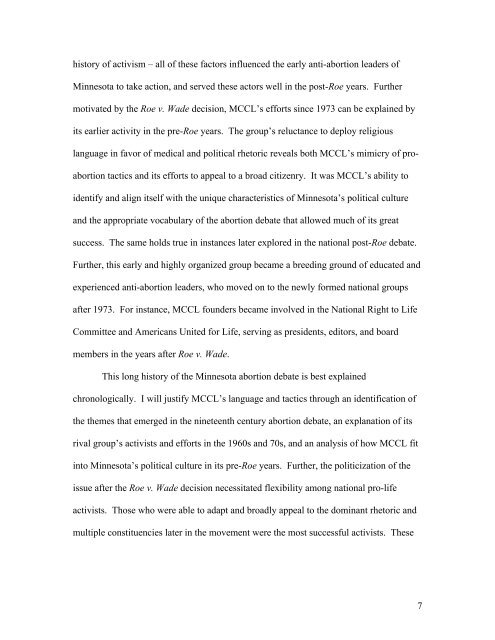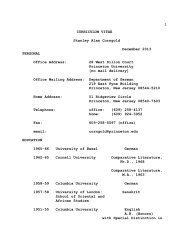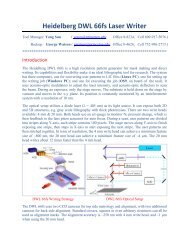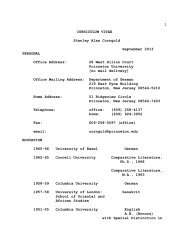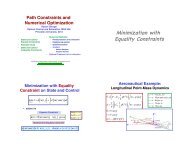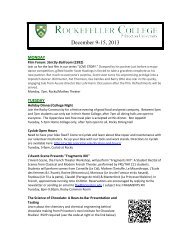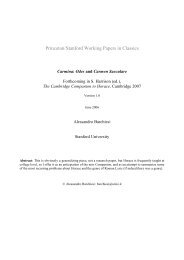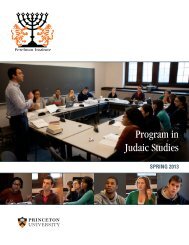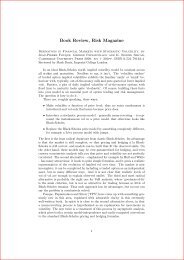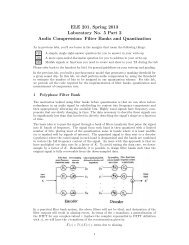The Pre-Roe Pro-Life Movement in Minnesota and New York
The Pre-Roe Pro-Life Movement in Minnesota and New York
The Pre-Roe Pro-Life Movement in Minnesota and New York
You also want an ePaper? Increase the reach of your titles
YUMPU automatically turns print PDFs into web optimized ePapers that Google loves.
history of activism – all of these factors <strong>in</strong>fluenced the early anti-abortion leaders of<br />
M<strong>in</strong>nesota to take action, <strong>and</strong> served these actors well <strong>in</strong> the post-<strong>Roe</strong> years. Further<br />
motivated by the <strong>Roe</strong> v. Wade decision, MCCL’s efforts s<strong>in</strong>ce 1973 can be expla<strong>in</strong>ed by<br />
its earlier activity <strong>in</strong> the pre-<strong>Roe</strong> years. <strong>The</strong> group’s reluctance to deploy religious<br />
language <strong>in</strong> favor of medical <strong>and</strong> political rhetoric reveals both MCCL’s mimicry of proabortion<br />
tactics <strong>and</strong> its efforts to appeal to a broad citizenry. It was MCCL’s ability to<br />
identify <strong>and</strong> align itself with the unique characteristics of M<strong>in</strong>nesota’s political culture<br />
<strong>and</strong> the appropriate vocabulary of the abortion debate that allowed much of its great<br />
success. <strong>The</strong> same holds true <strong>in</strong> <strong>in</strong>stances later explored <strong>in</strong> the national post-<strong>Roe</strong> debate.<br />
Further, this early <strong>and</strong> highly organized group became a breed<strong>in</strong>g ground of educated <strong>and</strong><br />
experienced anti-abortion leaders, who moved on to the newly formed national groups<br />
after 1973. For <strong>in</strong>stance, MCCL founders became <strong>in</strong>volved <strong>in</strong> the National Right to <strong>Life</strong><br />
Committee <strong>and</strong> Americans United for <strong>Life</strong>, serv<strong>in</strong>g as presidents, editors, <strong>and</strong> board<br />
members <strong>in</strong> the years after <strong>Roe</strong> v. Wade.<br />
This long history of the M<strong>in</strong>nesota abortion debate is best expla<strong>in</strong>ed<br />
chronologically. I will justify MCCL’s language <strong>and</strong> tactics through an identification of<br />
the themes that emerged <strong>in</strong> the n<strong>in</strong>eteenth century abortion debate, an explanation of its<br />
rival group’s activists <strong>and</strong> efforts <strong>in</strong> the 1960s <strong>and</strong> 70s, <strong>and</strong> an analysis of how MCCL fit<br />
<strong>in</strong>to M<strong>in</strong>nesota’s political culture <strong>in</strong> its pre-<strong>Roe</strong> years. Further, the politicization of the<br />
issue after the <strong>Roe</strong> v. Wade decision necessitated flexibility among national pro-life<br />
activists. Those who were able to adapt <strong>and</strong> broadly appeal to the dom<strong>in</strong>ant rhetoric <strong>and</strong><br />
multiple constituencies later <strong>in</strong> the movement were the most successful activists. <strong>The</strong>se<br />
7


